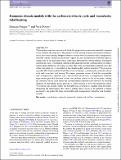Files in this item
Exomoon climate models with the carbonate-silicate cycle and viscoelastic tidal heating
Item metadata
| dc.contributor.author | Forgan, Duncan | |
| dc.contributor.author | Dobos, Vera | |
| dc.date.accessioned | 2016-04-29T15:30:04Z | |
| dc.date.available | 2016-04-29T15:30:04Z | |
| dc.date.issued | 2016-04-01 | |
| dc.identifier | 242261017 | |
| dc.identifier | 3e5f3109-331e-4200-80c7-e7f36bced9fb | |
| dc.identifier | 84963617443 | |
| dc.identifier | 000373580500009 | |
| dc.identifier.citation | Forgan , D & Dobos , V 2016 , ' Exomoon climate models with the carbonate-silicate cycle and viscoelastic tidal heating ' , Monthly Notices of the Royal Astronomical Society , vol. 457 , no. 2 , pp. 1233-1241 . https://doi.org/10.1093/mnras/stw024 | en |
| dc.identifier.issn | 0035-8711 | |
| dc.identifier.uri | https://hdl.handle.net/10023/8706 | |
| dc.description | DF gratefully acknowledges support from the ‘ECOGAL’ ERC advanced grant. VD has been supported by the Hungarian OTKA grant K104607, the Lend¨ulet-2009 Young Researchers Program of the Hungarian Academy of Sciences, the ESA PECS contract No. 4000110889/14/NL/NDe, the T´ET-14FR-1-2015-0012 project, and the NKFIH K-115709 grant of the Hungarian National Research, Development and Innovation Office. | en |
| dc.description.abstract | The habitable zone for exomoons with Earth-like properties is a non-trivialmanifold, compared to that of Earth-like exoplanets. The presence of tidal heating, eclipses and planetary illumination in the exomoon energy budget combine to produce both circumstellar and circumplanetary habitable regions. Analytical calculations suggest that the circumplanetary habitable region is defined only by an inner edge (with its outer limits determined by orbital stability). Subsequent calculations using 1D latitudinal climate models indicated that the combined effect of eclipses and ice-albedo feedback can produce an outer edge to the circumplanetary habitable zone. But is this outer edge real, or an artefact of the climate model's relative simplicity? We present an upgraded 1D climate model of Earth-like exomoon climates, containing the carbonate-silicate cycle and viscoelastic tidal heating. We conduct parameter surveys of both the circumstellar and circumplanetary habitable zones, and we find that the outer circumplanetary habitable edge remains provided the moon's orbit is not inclined relative to that of the planet. Adding the carbonate-silicate cycle pushes the circumplanetary habitable zone outwards, by allowing increases in atmospheric partial pressure of carbon dioxide to boost the greenhouse effect. Viscoelastic tidal heating widens the habitable zone compared to standard, fixed-Q models. Weakening the tidal heating effect due to melting allows moons to be habitable at higher eccentricity, and pushes the inner circumstellar and circumplanetary habitable zone boundary inwards. | |
| dc.format.extent | 9 | |
| dc.format.extent | 2971698 | |
| dc.language.iso | eng | |
| dc.relation.ispartof | Monthly Notices of the Royal Astronomical Society | en |
| dc.subject | Astrobiology | en |
| dc.subject | Methods: numerical | en |
| dc.subject | Planets and satellites: atmospheres | en |
| dc.subject | QB Astronomy | en |
| dc.subject | QC Physics | en |
| dc.subject | Space and Planetary Science | en |
| dc.subject | Astronomy and Astrophysics | en |
| dc.subject | NDAS | en |
| dc.subject | SDG 13 - Climate Action | en |
| dc.subject.lcc | QB | en |
| dc.subject.lcc | QC | en |
| dc.title | Exomoon climate models with the carbonate-silicate cycle and viscoelastic tidal heating | en |
| dc.type | Journal article | en |
| dc.contributor.sponsor | European Research Council | en |
| dc.contributor.institution | University of St Andrews. School of Physics and Astronomy | en |
| dc.identifier.doi | 10.1093/mnras/stw024 | |
| dc.description.status | Peer reviewed | en |
| dc.identifier.grantnumber | en |
This item appears in the following Collection(s)
Items in the St Andrews Research Repository are protected by copyright, with all rights reserved, unless otherwise indicated.

